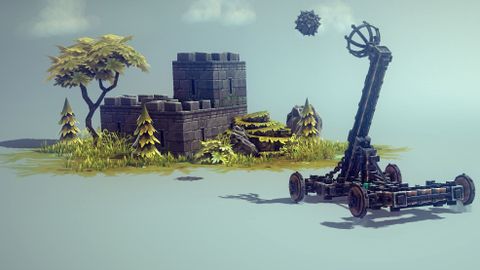Our Verdict
With a fun concept, superb creation tools, and finely crafted puzzles, Besiege is a construction game to savour.
PC Gamer's got your back
What is it? Construction game about building siege engines and smashing stuff.
Expect to pay $10/£7
Developer Spiderling Studios
Publisher Spiderling Studios
Reviewed on AMD Ryzen 5 3600, Nvidia Geforce RTX 2080 Super, 32GB RAM
Multiplayer Competitive and cooperative modes
Link Official site
Besiege is notionally a game about engineering medieval siege weapons. But I think of it as a metaphor for the creative process. It begins with inspiration. "Egads!" you probably won't cry. "A mobile artillery platform with seven cannons running along a manually adjustable beam would bring down those wooden airships. It's genius."
With that, you grab your virtual hammer and set about erecting your ridiculous death contraption, fuelled by the thrill of early creation. You'll hammer out the frame, align the wheels, affix the steering block, and prepare to line up your cannons. This is it, your masterwork. History will remember you for this.
Then you slap your forehead. You forgot to add a pivot for adjusting the vertical aim! You fix this, but now your vehicle is taller than the level allows, so you need to reduce the overall height, which also means increasing the power of your cannons so their shot will reach its target.
Finally, you exit the building mode and press play. You move the machine into position and fire, at which point the force of your cannons shreds the machine apart, and it collapses into a pile of splinters and flame. Congratulations! You just finished your first draft. Now to turn that smouldering mess of ideas into something that actually works.
Of course, Besiege is hardly the first game to do this. Games such as Crazy Machines and Kerbal Space Program let players indulge their inner crackpot scientist, constructing wildly ambitious contraptions before scratching their heads and muttering "perhaps a little more hydrazine" at the resulting mound of slag. Yet whereas Kerbal Space Program is a feast of fudged rocket science, Besiege is more like engineering tapas, breaking its challenge down into tiny, yet no-less tasty morsels.


Learning how to create steerable vehicles is a key skill in Besiege. Here are several different approaches.
Hinge Steering
Here, the front wheels are controlled by adjustable hinges. This is the most flexible steering model, but is hard to control and easily broken.
Opposing-force steering
Here, there are two sets of wheels. The inner wheels provide drive, while the outer wheels have opposite turning circles, which will cause the vehicle to turn in circles. This gives precise motor control, but the machine can only turn while stationary.
Torque steering
A wheel weighted by ballast sits on top of the machine, generating torque when it spins. This lets you turn and move simultaneously, with greater control than hinge steering, but has the downside of a larger turning circle.
The premise is vaguely reminiscent of Dungeon Keeper. Besiege points you toward a perfectly nice fantasy realm and orders you to completely ruin it. Only instead of building dungeons, you're building siege weapons. This realm is split into four separate Kingdoms, each of which comprises around a dozen individual levels.
These levels are beautifully presented dioramas of death, with a handful of environmental details delicately painted onto a plain, blueish background. Each stage presents you with a simple objective, starting with destroying a house. Your building area is outlined in front of the objective, inside which is a single metal cube that will form the crux of your contraption.
Besiege's toolkit is less intimidating than that of Kerbal Space Program, featuring an intuitive, LEGO-like construction system that lets you hammer out the basic frame of your siege weapon in seconds. This is as well, because Besiege's tutorial is lacking. It provides some guidance on how to build a basic buggy, but that's pretty much it, while its guide on how to create a steerable vehicle is actually the worst way of doing it.
Fortunately, this doesn't matter too much, as the best and funniest way of learning in Besiege is through failure. The various objects and materials you work with mirror real-life physics. Wood may seem like a sturdy construction material in theory, but when building a three-storey high catapult, dead trees get surprisingly bendy. When my trebuchet wobbles into position like a Saturday-night drunk, I quickly soon realise it's a good idea to shore-up constructions with metal braces. Similarly, if you build a machine that's heavily front-loaded with weapons, it's important to add ballast to the back end, otherwise it'll tip over the moment you switch from drive to reverse.

The toolkit boasts a broad range of objects. Alongside all the weapons you can festoon your machine with, there are ropes and winches for constructing cranes, propellers and wings for building flying machines, even tools for automation and rudimentary programming. Besiege also lets you tinker with the parameters of these objects at just the right level of depth, adjusting the 'speed' of wheels, the power of cannons, and assigning actions to individual key-bindings.
Besiege is at its best when it's encouraging creativity, presenting you with a problem that can be solved in multiple ways.
While the title implies a focus on the destruction of fortifications, the objectives you'll face in the campaign are far more varied than that. One level could require you to cut down a farmer's crops, while another might involve stealing a crystal from a bunch of druids. In this way, it constantly pushes you into coming up with new contraptions. Besiege has a good line in humour too, from the daft trumpet noises made by heralds to the way enemy units hop around as if they're being moved by a giant invisible toddler.
Besiege is at its best when it's encouraging creativity, presenting you with a problem that can be solved in multiple ways. Levels which require you to build a specific type of machine (particularly flying machines) tend to be more frustrating. On some levels, the bounding box of the build space is deliberately restricted, nudging you in a certain direction in a way I found annoying. Fortunately, you can also save machines you're particularly pleased with and load them up later. This lets you establish a range of blueprints you can tweak to suit a puzzle, useful for quickly solving specific-build challenges.

There are a couple of other minor issues. It would be nice if you could click-and-drag lengths of wood as you would paths in Planet Coaster. Not only would this make construction quicker, it would also make editing contraptions easier, as you could adjust sizes without necessarily having to delete and then rebuild entire sections of your machine. The camera can also be finicky sometimes, particularly when you're trying to line-up shots or work on the underside of your machine.
Nonetheless, for a game that costs $10, there's an impressive amount on offer here. The campaign will keep you occupied for a good 10-20 hours depending on how efficient a builder you are, while the level editor offers unlimited creative potential. It also has a strong multiplayer community, playable both cooperatively and competitively in what essentially amounts to medieval Robot Wars. If that doesn't sell you on Besiege, I'm not sure what will. All it's missing is a Craig Charles voiceover pack.
With a fun concept, superb creation tools, and finely crafted puzzles, Besiege is a construction game to savour.

Thanks to Fallout 4's disaster update, GOG's patch rollback feature makes it the best version of the game right now

The wild successes of Helldivers 2 and Baldur's Gate 3 send a clear message: Let devs cook

The solo developer of Manor Lords, Steam's latest smash hit, named his studio after a Witcher 3 meme
